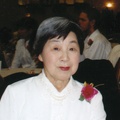This is a story told by Sachiko Masuoka about living through the atomic bombing of Hiroshima.
>> Part 2
We went to the fist aid station many times, but the scene was so terrible that I could not watch. I just covered my eyes. There was not enough help and it was humid and hot everyday. The flies were all over the burn patients. They planted eggs in their wounds, which, in a few days, turned into maggots. Soon they were covered with maggots. There was nothing they themselves could do. I believe many of them died because of that.
Everybody asked for water but I learned that drinking water is not good for burn patients. I tried to imagine how painful they must have felt not being able to drink water when they were so thirsty. I can still hear those people’s sad painful calls, “please give me some water, please give me some water.”
We gave water only to the patients that we felt had no hope of surviving. They said, “Oh it’s delicious.” Every one of them soon after took their last breath.
The burns were extraordinary. However, there was no medical help, no doctors and no one was treated. Many died, one by one. Later I heard that in some areas the patients were treated.
This is about the experience of one of my female relatives, who was a burn victim. She finally reached her home but she collapsed, could not move anymore and was bed ridden. Her mother patiently removed maggots one by one with a tweezers. Perhaps she applied some medicine to her burns. We never thought she would make it but she recovered, regained her health and lived many years after the bombing. She had pretty bad keloids on her face but she was able to marry. Therefore, I think if the patients had received proper care, many would not have had to die. Well, you know it was during the war, so....
A friend from my class received some burns on her face and has some keloids, but she is well. She lost her father in the bombing and she stayed single all her life to support two younger brothers, so they could go to college.
Do you know about the “A Bomb Virgins”? Twenty five young girls who had keloids on their faces were invited by the U.S. government to receive treatments. The keloids were so severe that children were afraid and ran away from them. Although the A Bomb Virgins had keloids on their faces, they were healthy otherwise and some of them were working. However, my heart aches when I think of these young ladies. Their psychological damage and pain must have been terrible.
This is what I heard from a young mother. Her little child was under the house. She was not able to lift up the part of the house, so she asked for help. Everyone was busy caring for themselves. While she was looking for someone to help her, the fire became too intense. Unable to get near her son, she decided to save another young child instead. She asked her son to forgive her. He called her, “stupid mama.” She was crying when she told me that she could still hear his voice to this day. I understand how difficult it must have been for her to abandon her own child when the fire was approaching with vengeance. On the other hand the little boy who was left to face the death alone must have been so frightened. There were so many who faced the same situation.
There was a lady who was not home at the time of the bombing. She volunteered to be the correspondent among her neighbors and she built a hut where her house used to be. I am not too certain, but by the end of September or October, she became ill. She had no way to go to the doctor and she passed in the matter of a few days. I think the reason of her death was radiation.
Speaking of radiation, I too received plenty of it. To this day, I have less than half of the white blood cells, compared to normal counts. I never know when I will get sick.
When I went to Japan two years ago, I met a man who was about four years younger than I was. According to his story, he lost both parents and all his siblings. He was the only survivor. He became what we call a war orphan. Fortunately, he was cared for by his uncle who had three girls and no boy, so he was welcomed and treated by the family as their own. At this time, he is quite wealthy and enjoys a family life. He told me how sad and forlorn he was when he became an orphan. He would never forget that empty feeling. He also told me that he never talked about his experience and how he felt because he thought no one would understand. He decided to tell me, because he felt I could understand because we shared the same experience. The wound he received is so deep and large.
You might understand a little about the conditions of the city after the bomb fell if you recall the terrorist attack in New York City. In that case it was only a small section of New York City but in the case of Hiroshima, it was not a part of the city but the entire city. Perhaps it was 100 or 1,000 fold of the area compared to New York City. Of course there was a difference of war time and peace time.
I wonder if everyone knows of the Hiroshima A Bomb Museum? The items displayed there represent just a very small part of the damage done. The display gives you just a glimpse of what actually happened. I do believe that one million words cannot properly explain what a terrible experience it was. I do not think what happened around me at that time will never leave my mind.
There are still many who are suffering from the effect of the bomb. Whenever I think of them, my heart aches for them. I fervently hope that one day we will have no war and be able to live in peace.
Though Japan lost the war, i will never forget the feeling of relief when the war ended. Every day I heard the sound of a hammer. Someone was building a little hut nearby to live in. I experienced that my country was returning to a peaceful existence. I found the breath of life in that sound.
We heard that there would be no plants and trees in Hiroshima for 75 years. However by the fall, perhaps the roots had survived and we saw cherry blossoms in the nearby park. Normally the cherry blossom blooms in the spring.
I ask everyone here not to give up but work hard for peace on earth.
Thank you for listening to my story.
* This article was originally published in Voices of Chicago, online journal of the Chicago Japanese American Historical Society.
© 2010 Sachiko Masuoka





